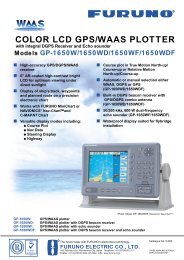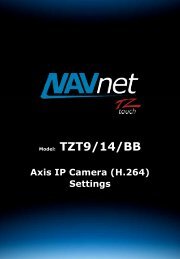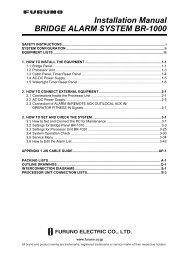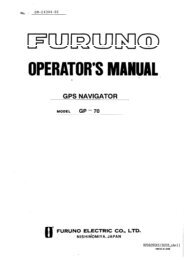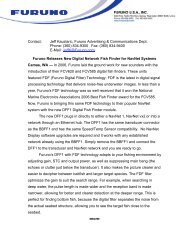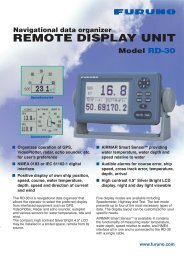LOUD HAILER - Furuno USA
LOUD HAILER - Furuno USA
LOUD HAILER - Furuno USA
You also want an ePaper? Increase the reach of your titles
YUMPU automatically turns print PDFs into web optimized ePapers that Google loves.
<strong>LOUD</strong> <strong>HAILER</strong><br />
LH-3000, LH-3000-CG
SAFETY INSTRUCTIONS<br />
WARNING<br />
Do not open the equipment.<br />
Only qualified personnel should work inside<br />
the equipment.<br />
Do not disassemble or modify the<br />
equipment.<br />
Fire, electrical shock or serious injury can<br />
result.<br />
Do not place liquid-filled containers on<br />
the top of the equipment.<br />
Fire or electrical shock can result if a liquid<br />
spills into the equipment.<br />
Immediately turn off the power at the<br />
switchboard if the equipment is emitting<br />
smoke or fire.<br />
Continued use of the equipment can cause<br />
fatal damage to the equipment. Contact a<br />
FURUNO agent for service.<br />
Make sure no rain or water splash leaks<br />
into the equipment.<br />
Fire or electrical shock can result if water<br />
leaks in the equipment.<br />
Keep heater away from equipment.<br />
A heater can melt the equipment's power<br />
cord, which can cause fire or electrical<br />
shock.<br />
Use the proper fuse.<br />
Use of a wrong fuse can result in damage<br />
to the equipment.<br />
CAUTION<br />
Do not use the equipment for other than<br />
its intended purpose.<br />
Use of the equipment for other than its<br />
intended purpose may result in damage to<br />
the equipment or cause bodlily injury.<br />
Observe the following compass safe<br />
distances to prevent interference to a<br />
magnetic compass:<br />
Standard<br />
compass<br />
Steering<br />
compass<br />
LH-3000 1.55 m 1.00 m<br />
LH-3010 2.15 m 1.40 m<br />
i
TABLE OF CONTENTS<br />
FOREWORD ........................................................................................................ iii<br />
SYSTEM CONFIGURATION................................................................................ iv<br />
EQUIPMENT LIST................................................................................................ iv<br />
1. INSTALLATION ................................................................................................ 1<br />
1.1 Mounting the Loud Hailer ..............................................................................................1<br />
1.2 Intercom Speaker (option) .............................................................................................3<br />
1.3 Wiring............................................................................................................................4<br />
2. OPERATIONAL OVERVIEW............................................................................ 9<br />
2.1 Controls.........................................................................................................................9<br />
2.2 Turning the Power On/Off............................................................................................10<br />
2.3 Adjusting Key Backlighting ..........................................................................................11<br />
2.4 Adjusting Output Level ................................................................................................11<br />
2.5 Adjusting Listening Volume .........................................................................................11<br />
2.6 Calling All Intercom Stations........................................................................................11<br />
2.7 Calling a Specific Intercom Station ..............................................................................12<br />
2.8 Receiving a Call from an Intercom Station...................................................................12<br />
2.9 Hailing by Voice...........................................................................................................13<br />
2.10 Sounding Warning Signals ..........................................................................................14<br />
2.11 Transmitting the Auxiliary Signal..................................................................................18<br />
2.12 Alarm Mode.................................................................................................................18<br />
2.13 Siren Mode (LH-3000-CG) ..........................................................................................20<br />
3. MAINTENANCE, TROUBLESHOOTING....................................................... 21<br />
3.1 Preventive Maintenance..............................................................................................21<br />
3.2 Replacing the Fuse .....................................................................................................22<br />
3.3 Troubleshooting...........................................................................................................22<br />
SPECIFICATIONS........................................................................................... SP-1<br />
PACKING LIST<br />
OUTLINE DRAWINGS<br />
INTERCONNECTION DIAGRAM<br />
ii
FOREWORD<br />
A Word to the Owner of the LH-3000, LH-3000-CG<br />
Congratulations on your choice of the FURUNO Loud Hailer LH-3000, LH-3000-CG. We are<br />
confident you will see why FURUNO has become synonymous with quality and reliability.<br />
For over 50 years FURUNO Electric Company has enjoyed an enviable reputation for<br />
innovative and dependable marine electronics equipment. This dedication to excellence is<br />
furthered by our extensive global network of agents and dealers.<br />
Your Loud Hailer is designed and constructed to meet the rigorous demands of the marine<br />
environment. However, no machine can perform its intended function unless installed,<br />
operated and maintained properly. Please carefully read and follow the recommended<br />
procedures for installation, operation and maintenance.<br />
We would appreciate hearing from you, the end-user, about whether we are achieving our<br />
purposes.<br />
Thank you for considering and purchasing FURUNO equipment.<br />
Features<br />
• Two types of specifications are available: LH-3000 and LH-3000-CG (for U.S. Coast<br />
Guard). The two are almost identical; the LH-3000-CG is additionally equipped with a<br />
Siren Mode. (Unless otherwise noted “LH-3000” refers to both LH-3000 and<br />
LH-3000-CG.)<br />
• 30 W audio output power to get another boat’s attention under almost any condition.<br />
• Eight internationally accepted warning signals can be selected for automatic operation for<br />
a variety of different maritime situations alerting nearby vessels of your presence and<br />
status in low visibility conditions.<br />
• Four intercom stations (speakers) may be connected to get 2-way communications<br />
between master station and one or all intercom stations.<br />
• LED indicators alert you to equipment status.<br />
• Keys are backlit for nighttime operation.<br />
• Smartly designed and intuitive front panel for ease of operation.<br />
• An auxiliary audio input allows transmission of music or other external audio signals (from<br />
cassette player, CD player, radio, etc.) to the intercom speakers, external horns or both.<br />
iii
SYSTEM CONFIGURATION<br />
iv<br />
Intercom Speaker<br />
(Max. 4)<br />
Forward Horn<br />
After Horn<br />
External Speaker<br />
Junction<br />
Box<br />
MIC<br />
Microphone<br />
EQUIPMENT LIST<br />
Standard supply<br />
PWR OFF<br />
ALL<br />
FWD<br />
AFT BOTH<br />
DIM<br />
IC 1 IC 2 IC 3 IC 4<br />
AUX<br />
YELP UNWY SAIL TOW<br />
FUNC/PTT<br />
MAN<br />
AUTOMATIC<br />
STOP ANCH AGND<br />
FUNC<br />
LISTEN<br />
HAIL<br />
VOL<br />
VOL<br />
System configuration<br />
13.6 VDC<br />
Remote Microphone<br />
Auxiliary Audio<br />
Source<br />
Alarm Sensor<br />
Name Type Code No. Qty Remarks<br />
Loud Hailer LH-3000<br />
LH-3000-CG<br />
1 See packing list for details.<br />
Microphone Set DM-2003 1 set<br />
Installation<br />
Materials<br />
1 set<br />
Spare Parts 1 set<br />
Template E52-00303 000-149-157 1<br />
Optional supply<br />
Name Type Code No. Qty Remarks<br />
Intercom Speaker LH-3010 000-149-111 1 Max. 4<br />
Flush Mount Kit LH-3020 000-149-112 1 See packing list.<br />
Twisted Pair Cable CO-SPEVV-SB-C<br />
0.2X2P<br />
000-111-680 1 5 m<br />
000-120-792 1 10 m<br />
000-120-793 1 15 m<br />
000-120-794 1 20 m<br />
: Standard Supply<br />
: Optional Supply<br />
: Local Supply
1. INSTALLATION<br />
1.1 Mounting the Loud Hailer<br />
The Loud Hailer can be mounted on a desktop, on the overhead, on a bulkhead or flush<br />
mounted in a panel (optional kit required). Refer to the mounting template (supplied) for<br />
installation instructions.<br />
Mounting considerations<br />
When planning the location for the Loud Hailer, keep in the mind the following<br />
considerations.<br />
Locate the unit where the front panel can be easily viewed and operated.<br />
Leave sufficient space at the sides and rear of your unit for ease of maintenance.<br />
Locate the unit as near to the power source as possible.<br />
The location should be out of direct sunlight because of heat that can build up inside the<br />
cabinet.<br />
Choose a location not subject to rain and salt spray.<br />
Locate the unit well away from sources of noise such as motors, alternators and<br />
generators.<br />
Mounting procedure<br />
Desktop, bulkhead, overhead mounting<br />
1. Attach rubber cushions (supplied) to the body of the Loud Hailer. Position the cushions<br />
so they locate across from the bottom of the slot in the hanger regardless of mounting<br />
method.<br />
Rubber<br />
cushion<br />
2. Fix the hanger to the mounting location with tapping screws (6x20).<br />
3. Screw knob bolts into the Loud Hailer.<br />
4. Set the Loud Hailer to the hanger and tighten knob bolts.<br />
1
1. INSTALLATION<br />
Flush mounting<br />
Requires flush mount kit LH-3020 (Code No. 000-149-112). See the flush mount outline<br />
drawing for details.<br />
2<br />
Contents of flush mount kit<br />
Name Type Code No. Qty<br />
Flush Mounting Plate TZ7300012A 999-999-025 2<br />
Screw 6X12 SUS304 999-999-027 2<br />
Wing Screw M4X35 SUS304 999-999-027 4<br />
Wing Nut M4 SUS304 999-999-028 4<br />
1. Make a cutout in the mounting location referring to flush mount outline drawing.<br />
2. Place the Loud Hailer in the cutout.<br />
3. Fix the two flush mounting plates to the Loud Hailer with screws.<br />
4. Screw the wing nuts on the wing screws.<br />
5. Fix the Loud Hailer with the wing bolts and then tighten the wing nuts.<br />
Loud hailer, flush mount
1.2 Intercom Speaker (option)<br />
1. INSTALLATION<br />
Four intercom speakers (maximum) may be connected to get 2-way communications<br />
between master station and one or all intercom speakers. For mounting dimensions and<br />
fixing instructions, see the outline drawing.<br />
Intercom speaker<br />
3
1. INSTALLATION<br />
1.3 Wiring<br />
All equipment are terminated at the rear panel of the LH-3000. See the illustration on the<br />
next page for how to connect equipment to terminals. Refer to the interconnection diagram<br />
for detailed information.<br />
Rear panel layout<br />
4<br />
J3<br />
13.6 VDC (Power),<br />
FWD and AFT<br />
terminals<br />
MIC, AUX, ALRM, PTT, CAL<br />
and SP (intercom speaker #4)<br />
terminals<br />
J2<br />
J1<br />
External Speaker<br />
SP and CAL (intercon<br />
station #1 - #3) terminals<br />
NOTICE<br />
Connect drain wires of armored cables to the ground terminal.<br />
Do not short them to the heat sink.<br />
LH-3000, rear panel<br />
Ground<br />
Terminal
Wiring<br />
1. INSTALLATION<br />
The illustration below shows how to connect the power supply. Other equipm ent are<br />
connected similarly.<br />
J3<br />
TERMINAL ARRANGEMENT<br />
J1<br />
J2<br />
J3<br />
- + - + - +<br />
AFT FWD 13.6V<br />
(4) Set terminal;<br />
tighten screws.<br />
J2<br />
J1<br />
- + - + - +<br />
AFT FWD 13.6V<br />
SP3 0V2 CAL2 SP1 <br />
0V3 CAL3 SP2 0V1 CAL1<br />
MIC PTT AUX ALRM SP4 <br />
0V 0V 0V 0V 0V4 CAL4<br />
- +<br />
(1) Unfasten screws.<br />
Jeweler's<br />
screwdriver<br />
LH-3000, rear panel, how to wire terminals<br />
(2) Pull out terminal.<br />
(3) Insert wire into terminal,<br />
and tighten screw at top<br />
of terminal.<br />
Note 1 : Connect power cables<br />
to the battery correctly.<br />
Note 2: Connection of intercom<br />
speaker cable to J2 or J3:<br />
Brown: CAL<br />
Red: SP1<br />
Black: OV1<br />
5
1. INSTALLATION<br />
Power connection<br />
The LH-3000 is intended for<br />
use with a 13.6 VDC power<br />
supply. Connect the power<br />
cable (loca l supply) to the<br />
terminals labeled “13.6V”.<br />
Use cable type DPYC-1.5 or<br />
equi v alent. Fabricate the<br />
cable as shown below. For<br />
longer runs the wire size of<br />
leads should be increased<br />
accordingly to minimize line<br />
losses. The wire connected to the positiv e (+) t erminal must be connected to the positiv e<br />
terminal on the DC power source, and the wire connected to the negativ e terminal (-) must<br />
be connected to the negative t erminal on the DC power source. If the power leads are<br />
rev ersed the fuse (inside t he Loud Hailer) will blow.<br />
Intercom speaker (option)<br />
Up to four intercom speakers may be connected to the intercom speaker terminals labeled<br />
CAL1-CAL4. Connect each speaker to the terminal block according to desired intercom<br />
speaker selection. The cable end is prefabricated. Howev er, to meet EMC requ irements the<br />
length of the cable must be less than 1 m. If the distance between the Loud Hailer and<br />
intercom speaker is greater than 2 m ( max. 20 m) , use a j unction box (l ocal supply) . For the<br />
connection to the j unction box use cable type CO-SPEVV-SB-C 0.2X2P (opt ion) an d<br />
fabricate it as below. In this case, the length of the cable between the j unction box and an<br />
intercom speaker must no be more than 1 m regardless of whether the equipm ent must<br />
meet EMC require ments or not.<br />
6<br />
Connection of speaker cable to<br />
Loud Hailer<br />
2 m max. Intercom<br />
Speaker<br />
J2 or J3 on Loud Hailer:<br />
Brown: CAL, Red: SP1, Black: OV1<br />
Distance between loud hailer and intercom speaker is less than 2 m.<br />
Loud Hailer<br />
2-20 m max. Junction<br />
Box<br />
1 m max.<br />
Distance between loud hailer and intercom speaker is 2-20 m.<br />
Outer sheath<br />
45<br />
Inner sheath<br />
Vinyl<br />
tape<br />
Sheath<br />
7<br />
11 7<br />
77 3<br />
Remove the outer sheath and<br />
armor by 45 mm.<br />
Twist and trim the shield.<br />
Armor<br />
Drain wire fabrication<br />
L*<br />
* Length long enough to<br />
15 5 reach ground terminal.<br />
Cut the sheath.<br />
Solder drain wire<br />
15 10<br />
Intercom<br />
Speaker<br />
Remove the inner sheath by 11 mm,<br />
and the sheath of the cores by 7 mm.<br />
Cut the unused cores.<br />
Solder a vinyl wire to the shield.<br />
Tape the sheath.<br />
Vinyl wire<br />
Fabrication of speaker cable<br />
Armor<br />
φ = 11.7 mm<br />
Conductor<br />
2<br />
S = 1.5 mm<br />
φ = 1.56 mm<br />
DPYC-1.5 Sectional view<br />
Sheath
Hailer horn (local supply)<br />
1. INSTALLATION<br />
Mount the hailer horns (local supply) facing away from the Loud Hailer to prevent feedback.<br />
They should also be pointed in the opposite direction of the microphone as you are<br />
speaking into it. Before mounting any horn, you should test it with the HAIL feature with the<br />
horn in the desired location to check for suitability of mounting location.<br />
Connect horns to the Loud Hailer with cable type DPYC-1.5 or equivalent. (See page 6 for<br />
how to fabricate this cable.) Be sure the cable is suitable for all-weather use. The<br />
terminating point on the terminal is either FWD or AFT depending on the location of the<br />
speaker.<br />
Burglar alarm (local supply)<br />
The unit can function as a burglar alarm by connecting an external alarm sensor (local<br />
supply) to the ALRM terminals. The alarm sensor should be a “normally open switch”. Use<br />
cable type TTYCS-1 or equivalent to connect the sensor. Fabricate the cable as shown<br />
below.<br />
When the sensor connected to the ALRM terminal becomes shorted and the alarm function<br />
is active, the yelp signal is released at maximum volume through both hailer horns.<br />
Shield<br />
77 3<br />
8<br />
Drain wire fabrication<br />
L*<br />
15<br />
7<br />
5<br />
Drain wire<br />
15 10<br />
Armor<br />
Twist and cut<br />
* Length long enough to<br />
reach ground terminal.<br />
Solder<br />
Vinyl tape<br />
Fabrication of cable TTYCS-1<br />
Armor<br />
Sheath<br />
Shield<br />
φ = 10.1 mm<br />
Conductor<br />
2<br />
S = 0.75 mm<br />
φ = 1.11 mm<br />
TTYCS-1 Sectional view<br />
7
1. INSTALLATION<br />
Floating ground<br />
The LH-3000 has a floating ground. What this means is that the heat sink ground is floating<br />
and will not ground batteries if they are connected to the ship’s chassis. To maintain a<br />
floating ground:<br />
1. Use a stereo plug when connecting a 4 ohm speaker to the external speaker plug.<br />
Connect it as shown in the illustration below.<br />
8<br />
Do not use for battery -<br />
use for ship's earth only<br />
Stereo plug<br />
2. Do not connect any of the output connectors on the rear panel to the ship’s ground.<br />
3. SP outputs are floating and must not be connected to either battery or the rear panel.<br />
Use a normal two conductor insulated speaker wire for the horn speaker.<br />
Output power<br />
The output power may be set for 30 W or 20 W, and the default settings is 30 W. For 20 W<br />
output contact a FURUNO agent or dealer for details.<br />
Note: If an external speaker is used it must be capable of handling the rated output power.<br />
Siren mode switch (for LH-3000-CG)<br />
To use the siren mode function, connect a toggle switch whose specifications are as shown<br />
below to the burglar alarm terminal.<br />
LH-3000C<br />
ALRM<br />
J3<br />
Toggle switch specifications<br />
4<br />
5<br />
SIREN<br />
OFF<br />
ALARM<br />
Circuit: SPDT (3P)<br />
Switching function: ON-OFF-ON<br />
Rating: 6A, 250 VAC<br />
Insulation resistance: 500 VDC, 100 Mohms min.<br />
Voltage breakdown: 1500 VAC (one minute)<br />
Contact resistance: less than 20 Mohms max.<br />
Alarm SENSOR
2. OPERATIONAL OVERVIEW<br />
2.1 Controls<br />
12<br />
11<br />
MIC<br />
Control description<br />
4<br />
3<br />
2<br />
1<br />
PWR OFF<br />
ALL<br />
IC 1<br />
YELP<br />
FUNC/PTT<br />
MAN<br />
FWD<br />
IC 2<br />
UNWY<br />
STOP<br />
LISTEN<br />
VOL<br />
10<br />
AFT BOTH<br />
IC 3<br />
SAIL<br />
AUTOMATIC<br />
IC 4<br />
TOW<br />
ANCH AGND<br />
8 9<br />
LH-3000, front view<br />
DIM<br />
HAIL<br />
VOL<br />
5 6<br />
1 [Hail Select] Key Chooses loud hailer speaker to use (ALL, FWD, AFT,<br />
BOTH).<br />
2 [Intercom Select] Key Chooses which intercom station (IC1, IC2, IC3, IC4) to<br />
call.<br />
3 [Upper Signal Select] Key Chooses warning signal among YELP, UNWY, SAIL and<br />
TOW.<br />
4 [Lower Signal Select] Key Chooses warning signal among MAN, STOP, ANCH and<br />
AGND.<br />
5 [DIM] Key<br />
Adjusts indicator backlighting, in five levels, including off.<br />
6 [AUX] Key Transmits audio signal from external source to all intercom<br />
stations.<br />
AUX<br />
FUNC<br />
7<br />
9
2. OPERATION<br />
7 [FUNC] Key<br />
10<br />
Activates automatic and manual warning signals.<br />
8 [LISTEN VOL] Control Adjusts listening volume from the internal speaker; turns<br />
power on/off.<br />
9 [HAIL VOL] Control Adjusts output volume from the horn speakers or intercom<br />
station speakers.<br />
10 LED Indicators From top row:<br />
- Hail indicators (ALL, FWD, AFT BOTH)<br />
- Intercom indicators (IC1 – IC4)<br />
- Alarm signal indicators (YELP(manual), UNWY, SAIL,<br />
TOW)<br />
- FUNC/PTT and AUTOMATIC indicators<br />
- Alarm signal indicators (MAN(manual), STOP, ANCH,<br />
AGND)<br />
11 MIC MIC input<br />
12 Speaker<br />
2.2 Turning the Power On/Off<br />
Turn the [LISTEN VOL] control clockwise to turn on the Loud Hailer. The “ALL” indicator<br />
lights, which means the Loud Hailer is in standby and awaiting your command.<br />
The equipment is in the standby mode when the “ALL” indicator is lit. Normally, the<br />
equipment should be returned to the standby mode after a function has been completed. In<br />
the standby mode the Loud Hailer is ready to call all stations, including both horn speakers<br />
and all intercom stations, and is ready to receive a call from any intercom station.
2.3 Adjusting Key Backlighting<br />
2. OPERATION<br />
You may adjust the intensity of the key backlighting cyclically with the [DIM] key, in five<br />
levels, including off.<br />
2.4 Adjusting Output Level<br />
Turn the [HAIL VOL] control to adjust the output volume from the horn speakers or intercom<br />
speakers. Clockwise rotation increases volume; counterclockwise rotation decreases it.<br />
2.5 Adjusting Listening Volume<br />
Turn the [LISTEN VOL] control to adjust the listening volume from the Loud Hailer’s internal<br />
speaker and external speaker (if connected).<br />
2.6 Calling All Intercom Stations<br />
1. In the standby mode, hold the microphone 2-3 cm from your mouth and press the PTT<br />
switch on the microphone. Speak into the microphone. All intercom stations and both<br />
horn speakers will hear you.<br />
2. After speaking, release the PTT switch to return the equipment to the standby mode.<br />
Note: To call all intercom stations while sounding warning signals, see page 17.<br />
11
2. OPERATION<br />
2.7 Calling a Specific Intercom Station<br />
1. Press the [Intercom Select] key until the indicator lights on the desired intercom station.<br />
After a one-second delay, a short tone sounds from the selected intercom station.<br />
2. Press the PTT switch on the microphone and speak into the microphone.<br />
3. Release the PTT switch to listen for a reply from the selected intercom station. If<br />
necessary, adjust listening volume with the [LISTEN VOL] control.<br />
4. After completing your conversation, press the [Hail Select] key to return to the standby<br />
mode.<br />
Note: To call a specific intercom stations while sounding warning signals, see page 17.<br />
2.8 Receiving a Call from an Intercom Station<br />
When an intercom station is calling the main station, the indicator for the calling station<br />
flashes on the main station’s indicator and a tone sounds while the intercom station<br />
operator is pressing the station’s calling switch.<br />
Automatically selecting a single calling station<br />
1. In the standby mode, press the PTT switch on the microphone to answer the call. The<br />
LH-3000 automatically switches to the calling station and the flashing indicator then<br />
lights steadily.<br />
2. If necessary, adjust listening volume with [LISTEN VOL] control.<br />
3. After you have finished your conversation, press the [Hail Select] key to return to the<br />
standby mode.<br />
Automatically selecting multiple calling stations<br />
When you receive a call from more than one station, the appropriate intercom station<br />
indicators flash and a tone sounds.<br />
1. In the standby mode, press the PTT switch on the microphone. When calls are received<br />
simultaneously, the low-number station will be selected first.<br />
2. After you have completed your conversation, press the [Hail Select] key to return to the<br />
standby mode.<br />
3. Press the PTT switch on the microphone again and the next low-number station will<br />
automatically be selected.<br />
4. After you have finished all intercom conversations, press the [Hail Select] key to return<br />
to the standby mode (“ALL” indicator lights).<br />
Calling all intercom stations while an intercom voice is selected<br />
1. Press and hold the [Hail Select] key.<br />
2. Press the PTT switch on the microphone and speak into the microphone. All station<br />
indicators flash.<br />
12
Manually selecting a calling station<br />
2. OPERATION<br />
1. Press the [Intercom Select] key until the indicator lights for the desired station.<br />
2. Press the PTT switch on the microphone and answer the call.<br />
3. Release the PTT switch to listen to the intercom station. Adjust listening volume with the<br />
[LISTEN VOL] control if necessary.<br />
4. To call another station, select the next station with the [Intercom Select] key.<br />
5. After you have finished all conversations, press the [Hail Select] key to return to the<br />
standby mode.<br />
Intercom station operation<br />
Press the button on the intercom to call. Release the button to listen.<br />
2.9 Hailing by Voice<br />
1. Press the [Hail Select] key until the indicator lights for the desired horn speaker(s).<br />
2. Press the PTT switch on the microphone and speak into the microphone. If necessary,<br />
adjust the output power to the speaker(s) with the [HAIL VOL] control.<br />
3. Release the PTT switch and the Loud Hailer will switch to the listening mode, using the<br />
speaker(s) as microphone(s). If necessary, adjust listening volume with the [LISTEN<br />
VOL] control.<br />
4. After speaking, press the [Hail Select] key to return to the standby mode.<br />
13
2. OPERATION<br />
2.10 Sounding Warning Signals<br />
Your Loud Hailer has eight different warning signals: two manual and six automatic. The two<br />
manual signals, YELP and MAN, are designed to be sounded at each press of the PTT<br />
switch on the microphone. The six automatic signals are sounded when the [FUNC] key is<br />
operated.<br />
Only the horn speakers sound warning signals and the volume is automatically set to<br />
maximum when sounding warning signals.<br />
Description of warning signals<br />
Manual warning signals<br />
MAN: Signal for passing. The lengths and timing of the horn blasts are controlled by<br />
pressing the PTT switch on the microphone.<br />
YELP: Yelp type emergency siren.<br />
Automatic warning signals<br />
14<br />
250 Hz<br />
500 Hz<br />
Yelp signal<br />
UNWY: Warning signal for power-driven vessels underway. One 5-second blast at 120<br />
second interval intervals.<br />
5 s<br />
120 s<br />
Underway signal<br />
1 s
2. OPERATION<br />
SAIL: Warning signal for sailboats, tug boats and tow boats underway. One 3-second<br />
blast, followed by one 2-second interval, one 1-second blast, one 2-second<br />
interval and one 1-second blast. Repeated every 120 seconds.<br />
3 s<br />
2 s<br />
1 s<br />
2 s<br />
1 s<br />
120 s<br />
Sailing signal<br />
TOW: Warning signal for vessels under tow. One 3-second blast, followed by one<br />
2-second interval, one 1-second blast, one 2-second interval, one 1-second blast,<br />
one 2-second interval, and one 1-second blast. Repeated every 120 seconds.<br />
3 s<br />
2 s<br />
1 s<br />
2 s<br />
1 s<br />
2 s<br />
1 s<br />
120 s<br />
Towing signal<br />
STOP: Warning signal for power-driven vessel that is stationary. Two 3-second blasts,<br />
with a 2-second interval between each blast, repeated every 120 seconds.<br />
3 s<br />
2 s<br />
3 s<br />
120 s<br />
Stop signal<br />
15
2. OPERATION<br />
ANCH: Warning signal for vessels at anchor. A rapidly ringing bell tone sounds for a<br />
duration of 5 seconds, repeated at an interval of 60 seconds.<br />
16<br />
5 s<br />
60 s<br />
Anchor signal<br />
AGND: Warning signal for vessels aground. Two bell tones of 0.5 seconds, a bell tone of<br />
1 second followed by a rapidly ringing bell tone for a duration of 5 seconds,<br />
followed by a bell tone of 2 seconds and 0.5 seconds. Repeated once every 60<br />
seconds.<br />
0.5 s 0.5 s 1 s 5 s 2 s 0.5 s 0.5 s<br />
Sounding a manual warning signal<br />
60 s<br />
Aground signal<br />
1. Press the [Hail Select] key until the indicator lights for the desired horn speaker(s). If no<br />
selection is made, “BOTH” will be automatically selected when a warning signal is<br />
initiated.<br />
2. Press the [Upper Signal Select] key to select YELP or press the [Lower Signal Select]<br />
key to select MAN. The indicator begins flashing for the desired signal.<br />
3. Press the [FUNC] key to activate the warning signal. The indicator stops flashing and<br />
lights steadily.<br />
4. Press the PTT switch on the microphone to sound the warning signal. Each time the<br />
PTT switch is pressed, the warning signal will sound until the PTT switch is released.<br />
When the PTT switch is released the equipment will return to the listen mode. Adjust the<br />
[LISTEN VOL] control if necessary.<br />
5. To temporarily interrupt manual signals with voice transmissions do the following:<br />
1) Press the [Hail Select] key. The indicator for the chosen signal flashes to indicate the<br />
signal is still selected, but not active.<br />
2) Press the PTT switch on the microphone and speak into the microphone. Your voice will<br />
sound to all stations.<br />
3) Release the PTT switch again to return to manual warning signals.
Sounding an automatic warning signal<br />
2. OPERATION<br />
1. Press the [Hail Select] key until the indicator lights for the desired horn speaker(s). If no<br />
selection is made, “BOTH” will be automatically selected when a warning signal is<br />
initiated.<br />
2. Press the [Upper Signal Select key] to select UNWY, SAIL or TOW or press the [Lower<br />
Signal Select] key to select STOP, ANCH or AGND until the indicator flashes for the<br />
desired signal.<br />
3. Press the [FUNC] key to activate the automatic warning signal. The indicator stops<br />
flashing and lights and then the signal is sounded from the selected horn speaker(s).<br />
4. To temporarily interrupt automatic signals with voice transmissions, press the [FUNC]<br />
key. The indicator for the chosen signal flashes to indicate the signal is still selected, but<br />
not active.<br />
5. Press the PTT switch on the microphone and speak into the microphone. Your voice<br />
sounds from the chosen horn speaker(s).<br />
6. Release the PTT switch and press the [FUNC] key again to return to automatic warning<br />
signals.<br />
7. To stop transmitting automatic warning signals, press the [FUNC] key followed by the<br />
[Hail Select] key to return to the standby mode.<br />
Calling intercom stations while sounding warning signals<br />
Calling all intercom stations<br />
1. While pressing and holding down the [Hail Select] key, press the PTT switch. All<br />
intercom indicators flash.<br />
2. Press the PTT switch on the microphone and speak into the microphone.<br />
3. After speaking, release the PTT switch and then the [Hail Select] key to return to the<br />
chosen warning signal.<br />
Calling a specific intercom station<br />
1. Press the [Intercom Select] key until the indicator lights on the desired intercom station.<br />
A short tone sounds from the selected intercom one second after choosing a station.<br />
2. Press the PTT switch on the microphone and speak into the microphone.<br />
3. Release the PTT switch to listen to the reply from the selected intercom station. If<br />
necessary, adjust the listening volume with the [LISTEN VOL] control.<br />
4. After you have finished your conversation, press the [Hail Select] key to return to the<br />
standby mode. Signal activity on the selected horn speaker will be restored.<br />
17
2. OPERATION<br />
2.11 Transmitting the Auxiliary Signal<br />
Transmitting the auxiliary signal over all speakers<br />
An audio signal from an external audio source can be transmitted through the equipment<br />
via the AUX input connector on the rear panel.<br />
1. In the standby mode, press the [AUX] key. The signal from the external AF source (radio,<br />
CD player, etc.) sounds from all intercom stations and any connected horn speakers.<br />
Adjust the output volume level directly from the external input source.<br />
2. To turn off the external AF signal, press the [AUX] key to return to the standby mode.<br />
Transmitting the auxiliary signal over all intercom stations<br />
1. Press and hold the [Intercom Select] key.<br />
2. Press the [AUX] key.<br />
Returning auxiliary transmission to standby mode<br />
Press the [AUX] key twice.<br />
2.12 Alarm Mode<br />
The LH-3000 can operate as a burglar alarm by connecting an external, normal-open switch<br />
to the ALRM terminals on the rear panel.<br />
Both horn speakers are selected automatically when the alarm mode is enabled. If the<br />
alarm is triggered, the volume output is automatically set to maximum.<br />
Enabling the alarm mode<br />
1. Press and hold down the [Upper Signal Select] key until the YELP indicator flashes.<br />
Note that you may light the MAN indicator (with the [Lower Signal Select] key) instead of<br />
the YELP indicator.<br />
2. Press the [FUNC] key until the ALL, FWD, AFT and BOTH indicators light. The YELP<br />
indicator goes off.<br />
3. After approximately five minutes, the ALL, FWD, AFT and BOTH indicators go off. Then<br />
the equipment goes into standby, lighting the BOTH indicator every four seconds to<br />
indicate standby mode.<br />
See the next page for procedure flow.<br />
When an attempt is made to remove the Loud Hailer<br />
When an attempt is made to remove the Loud Hailer, the alarm sound is released through<br />
both horn speakers at maximum volume. The alarm sounds for two minutes followed by a<br />
five-minute rest time. The BOTH indicator lights every four seconds during the sounding of<br />
the alarm or the five-minute rest period.<br />
18
Disabling the alarm mode<br />
Press any key or switch other than the [AUX] or [DIM] key, or turn off the power.<br />
Enable alarm<br />
Press the [Lower Signal<br />
Select] key to flash<br />
the YELP indicator.<br />
Press the [FUNC] key.<br />
An attempt is made<br />
to remove the<br />
Loud Hailer with<br />
alarm mode active<br />
2. OPERATION<br />
ALL, FWD, AFT and BOTH indicators light.<br />
YELP indicator goes off.<br />
After 5 minutes<br />
ALL, FWD, AFT and BOTH indicators go off.<br />
BOTH indicator lights every four seconds.<br />
STANDBY STATUS<br />
(Alarm mode enabled)<br />
Alarm sound is released through both horn<br />
speakers at maximum volume.<br />
Silence/cancel alarm<br />
Press any key except AUX or DIM,<br />
or turn off the power.<br />
Alarm setting/cancel flow<br />
19
2. OPERATION<br />
2.13 Siren Mode (for LH-3000-CG)<br />
Enabling the siren mode<br />
The siren mode, activated by a switch connected to the burglar alarm terminal, functions to<br />
sound the warning signal (YELP) from both horn speakers in the standby mode. To interrupt<br />
the warning signal to speak, press the PTT switch on the microphone and speak into it.<br />
Communicating with intercom stations while in the siren mode<br />
You may communicate with intercom stations in the siren mode. However, unlike the<br />
standby mode, you must choose intercom stations.<br />
1. In the siren mode, press the [Intercom Select] key until the indicator lights on the desired<br />
intercom station. After a one-second delay, a short tone sounds from the selected<br />
intercom station.<br />
2. Press the PTT switch on the microphone and speak into it.<br />
3. Release the PTT switch to listen for a reply from the selected intercom station. If<br />
necessary, adjust listening volume with the [LISTEN VOL] control.<br />
4. After completing your conversation, press the [Hail Select] key to return to the siren<br />
mode.<br />
Talking to ALL intercom stations while in the siren mode<br />
You may talk to ALL intercom stations. However, unlike the standby mode, you must<br />
choose intercom stations.<br />
1. In the siren mode, press the [Intercom Select] key until the indicator lights on the desired<br />
intercom station.<br />
2. Press and hold down the [Hail Select] key, then press the PTT switch and talk into the<br />
microphone.<br />
3. After speaking, release the PTT switch and then the [Hail Select] key to return to the<br />
siren mode.<br />
Disabling the siren mode<br />
Turn off the siren mode switch, and the LH-3000-CG stops sounding.<br />
20
3. MAINTENANCE, TROUBLESHOOTING<br />
Periodic checks and maintenance are important for maintaining performance. This chapter<br />
contains maintenance and troubleshooting instructions to be followed to obtain optimum<br />
performance and the longest possible life of the equipment.<br />
WARNING<br />
Do not open the equipment.<br />
Only qualified personnel should work inside<br />
the equipment.<br />
3.1 Preventive Maintenance<br />
General checks<br />
Check the following monthly.<br />
Check all cabling. If damaged, replace.<br />
Check connections. Retighten if necessary.<br />
Measure the input voltage to be sure it is within the rated voltage (13.6 VDC ±20%).<br />
Cleaning<br />
Dust or dirt should be removed from exterior surfaces with a soft, dry cloth. Do not use<br />
chemical-based cleaners to clean the Loud Hailer – they can remove paint and markings.<br />
21
3. MAINTENANCE, TROUBLESHOOTING<br />
3.2 Replacing the Fuse<br />
The 6A fuse inside the Loud Hailer protects it from reverse polarity and equipment fault. If<br />
the power cannot be turned on, the fuse may have blown. Have a qualified technician check<br />
the fuse.<br />
3.3 Troubleshooting<br />
22<br />
Use the proper fuse.<br />
WARNING<br />
Use of a wrong fuse can result in damage<br />
to the equipment or cause fire.<br />
Below are simple troubleshooting procedures which the user may follow to try to restore<br />
normal operation. If normal operation cannot be restored, do not attempt to check inside<br />
any unit. Any repair work is best left to a qualified technician.<br />
Troubleshooting table<br />
If… Then…<br />
power cannot be turned on check that the power cable is tightly connected.<br />
fuse may have blown. Have a qualified technician<br />
check the fuse.<br />
you cannot hear voice from an intercom adjust the [LISTEN VOL] control.<br />
station<br />
output volume is too low adjust the [HAIL VOL] control.
FURUNO LH-3000/LH-3000-CG<br />
1 AUDIO OUTPUT<br />
1.1 Hail speaker 30 W, 8 ohms<br />
1.2 Intercom speaker 4.5 W, 4 ohms<br />
1.3 External speaker 4.5 W, 4 ohms<br />
1.4 Internal speaker 2.5 W, 4 ohms<br />
2 INPUT IMPEDANCE<br />
2.1 MIC impedance 600 ohms<br />
2.2 Aux impedance 10K ohms<br />
SPECIFICATIONS OF <strong>LOUD</strong> <strong>HAILER</strong><br />
LH-3000/LH-3000-CG<br />
3 INPUT SENSITIVITY<br />
3.1 MIC sensitivity -73 ±3 dB (0 dB=1V/µBar)<br />
3.2 Aux sensitivity 0 dBm ±3 dB (at 1 kHz)<br />
4 DISTORTION FACTOR<br />
4.1 Hail mode 10% (1 kHz 30 W)<br />
4.2 Intercom mode 10% (1 kHz 2.5 W)<br />
5 SIGNAL-TO-NOISE<br />
5.1 Hail mode 60 dB (1 kHz)<br />
5.2 Intercom mode 60 dB (1 kHz)<br />
6 POWER SUPPLY<br />
12 VDC, less than 5A, less than 280 mA (standby)<br />
7 ENVIRONMENTAL CONDITIONS<br />
7.1 Ambient temperature -15 to 55°C<br />
7.2 Relative humidity 95% at 40°C<br />
7.3 Waterproofing IPX5 (Front panel), IPX0 (Other)<br />
8 COLOR<br />
N3.0<br />
9 SIREN MODE (LH-3000-CG)<br />
Sounds warning signal in standby.<br />
SP - 1 E5646S01C
This page is intentionally left blank.
9-52 Ashihara-cho,<br />
Nishinomiya 662-8580, JAPAN<br />
Telephone : 0798-65-2111<br />
Fax : 0798-65-4200<br />
All rights reserved.<br />
( DAMI ) LH-3000<br />
Pub. No. OME-56460<br />
Printed in Japan<br />
FURUNO Authorized Distributor/Dealer<br />
FIRST EDITION : FEB. 2004<br />
The paper used in this manual<br />
is elemental chlorine free.<br />
B : MAY. 26, 2005<br />
*00014911811*<br />
*00014911811*<br />
* 0 0 0 1 4 9 1 1 8 1 1 *<br />
*OME56460B00*<br />
*OME56460B00*<br />
* O M E 5 6 4 6 0 B 0 0 *







